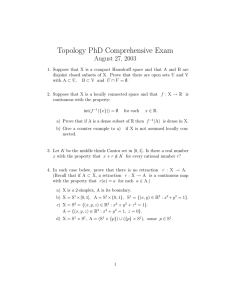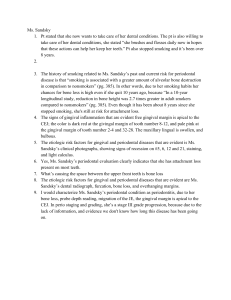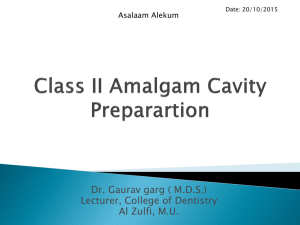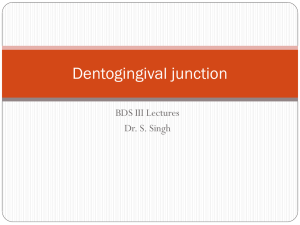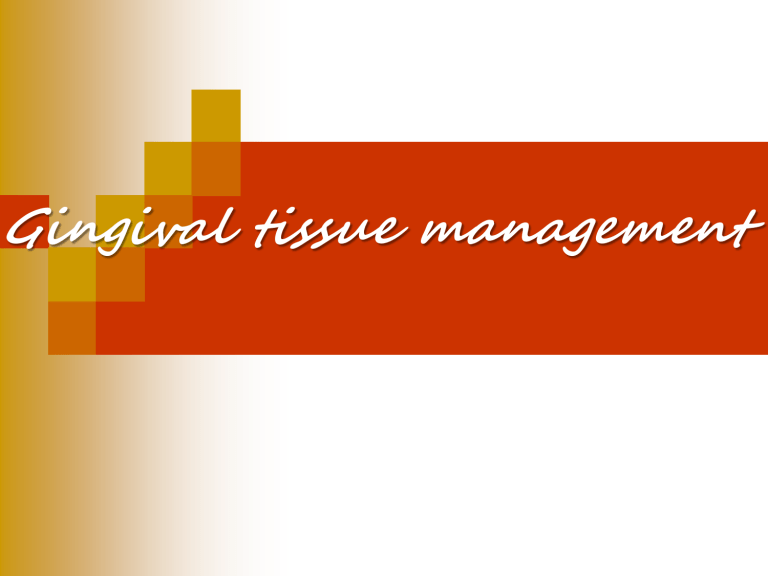
Gingival tissue management Contents :◼ INTRODUCTION ◼ DEFINITION ◼ GOALS ◼ INDICATIONS OF GINGIVAL RETRACTION ◼ TECHNIQUES OF GINGIVAL RETRACTION. ◼ SUMMARY ◼ CONCLUSION ◼ REFERENCES Introduction ◼ Gingiva is retracted to obtain maximum exposure of finish line and to atraumatically allow access for the impression material beyond the abutment margin. ◼ To create space in order to provide sufficient thickness of impression material in gingival sulcus region so that it can better withstand the tearing forces encountered during removal of impressions. . DEFINITION Gingival displacement is defined as the deflection of marginal gingiva away from the tooth. (GPT 8) GOALS ◼ Maintaining DRY CLEAN ENVIRONMENT. ◼ Improves ACCESS AND VISIBILITY. ◼ Improves the PROPERTIES OF DENTAL MATERIALS. ◼ PROTECTING the adjacent soft tissues. TECHNIQUES OF GINGIVAL RETRACTION Classification ◼ Mechanical methods ◼ Chemical mechanical methods ◼ Surgical Dent Clin N Am 48 (2004) 433–444 MECHANICAL METHODS OF GINGIVAL RETRACTION MECHANICAL METHODS ◼ Mechanically displaces gingival tissues outwards and apically away from the tooth surface. ◼ Indicated in cases where gingiva is normal. ◼ Provides minimal gingival retraction. ➢ Copper band ➢ Retraction cord COPPER BAND COPPER BAND ◼ It is used to carry the impression material as well as to displace the gingiva to expose the finish line. TECHNIQUE OF COPPER BAND ◼ ◼ ◼ Copper band is a welded tube corresponding to the size of the prepared tooth. One end of the tube is trimmed to follow the outline of the gingival finish line. After positioning and contouring the prepared tooth it is filled with modeling compound and the impression is made. DISADVANTAGE OF COPPER BAND Causes injury to the gingival tissues RETRACTION CORD Gingival retraction cord. - retracts gingival tissues and controls GCF/small amounts of bleeding. TYPES OF RETRACTION CORD 1) Cotton 2) Synthetic 1) Braided 2) Twisted 3) Woven 1) Coarse 2) Fine 1) Impregnated 2) Non-impregnated Cord may be saturated with solution ◼ Prior to insertion. ◼ Placed dry, solution applied. ◼ Previously impregnated by manufacturer. Desirable qualities of cord ◼ Dark color to maximize contrast with tissues and tooth. ◼ Absorbent to allow for uptake of wet medicament. ◼ Available in different diameters to accommodate varying morphologies of gingival sulcus. IDEAL REQUIREMENTS OF CHEMICALS USED FOR GINGIVAL RETRACTION CORDS ◼ Should produce effective gingival displacement and haemostasis ◼ It should not produce any irreversible damage to gingiva ◼ It should not have any systemic side effects CHEMICALS USED FOR GINGIVAL RERACTION They are generally local vasoconstrictors which produce gingival shrinkage. ◼ ◼ ◼ ◼ ◼ 8 % racemic epinephrine Aluminium chloride(15-29%) Alum(aluminium potassium sulphate) (100%) Aluminium sulphate Ferric sulphate (13-20%) TECHNIQUE OF USING RETRACTION CORD ◼ The cord can be packed with a special instrument like Fischer packing instrument or a DE plastic instrument . CHEMICO-MECHANICAL METHODS OF GINGIVAL RETRACTION Single cord technique ◼ For making impression of multiple prepared teeth ◼ When tissue health is compromised ◼ When procedure delay is not possible ◼ ◼ ◼ ◼ Small diameter cord is placed Cut the ends… so that they can exactly abut against each other Cord is left in sulcus during impression making If cord is short, it may impregnate in impression, that cause difficulty in pouring and trimming of the die After careful preparation of cervical margin ◼ Control hemorrhage using specially designed dentoinfusor with the ferric sulphate medicament ◼ 20% ferric sulphate is preferred because it is less acidic ◼ Infuser is carried circumferentially 3600 around the sulcus ◼ ◼ ◼ ◼ ◼ Anterior tooth preperations cord placement may result is strangulation of gingival papilla & eventually loss of papilla This creates unaesthetic black triangle in embrasure area Place the retraction cord at the most distal prepared tooth No cord is placed around the prepared tooth mesial to this tooth SURGICAL METHODS OF RETRACTION SURGICAL METHODS OF GINGIVAL RETRACTION Surgical methods are: ◼ GINGETTAGE ◼ ELECTROSURGERY Rotary curettage Gingettage ROTARY CURETTAGE (GINGETTAGE) ◼ It is a toughing technique , wherein a portion of the epithelium within the sulcus is removed to expose the finish line. ◼ It should be done only on the healthy gingival tissue CRIETERIA TO BE FULLFILLED FOR GINGETTAGE ◼ There should be no bleeding on probing ◼ The depth of the sulcus should be minimum of 3 mm TECHNIQUE OF GINGETTAGE ◼ It is usually done simultaneously along with finish line preparation ◼ Portion of sulcular epithelium is removed using a torpedo diamond bur. ◼ To improve tactile sense headpiece is run very slowly ◼ Abundant water should be sprayed during the procedure ◼ A retraction cord is impregnated with AlCl3 can be used to control bleeding ELECTROSURGICAL RETRACTION ELECTROSURGICAL RETRACTION ◼ It is the surgical retraction of the sulcular epithelium using an electrode to produce gingival retraction ◼ The procedure is called surgical diathermy. SURGICAL ELECTRODE or THE CUTTING ELECTRODE It is like a probe and produces intense heat during surgical procedures Current flows from a small cutting electrode that produces a high current density and a rapid temperature rise at its point of contact with the tissue The cells directly adjacent to the electrode are destroyed by this temperature increase New materials ◼ ◼ ◼ ◼ Magic foam cord Merocel Expasyl Laser Magic foam cord First Expanding VPS Material Designed For Easy & Fast Retraction Of Sulcus Without Potentially Traumatic Packing Or Pressure. Merocel ◼ Synthetic Material, Chemically Extracted From A Biocompatible Polymer (HydroxylatePolyvinyl Acetate) That Creates A Net Like Strip -Capable Of Atraumatic Gingival) ◼ Used In Strips Of 2mm Thickness That Expand With absorption Of Selected Oral Fluids ◼ Commonly Used In E.N.T, Gastric, Thoracic & Oto neurosurgical Procedures Expasyl - - - When homeostasis & sulcus opening is required Has white clay (kaolin), water, aluminum chloride Paste is injected into sulcus with pressure of 0.1N/nm. Left in place for 1 min Sulcus opening of 0.5mm is obtained Supplied in reusable capsules, injection canulas, applicator. Use of LASERS for retraction ◼ ◼ ◼ ◼ ◼ Laser is an acronym from Light amplification by stimulated emission of radiation. Laser systems are composed of an active medium, which may be a solid (Nd:YAG laser and Er:YAG laser) or a gas (CO2 lasers). Summary ◼ Gingival retraction holds an important place during soft tissue management before an impression is made. Several problems that can arise from poor marginal fit of fixed dental prostheses can be prevented if the margins of prepared tooth are recorded after adequate exposure by any of the mentioned gingival retraction methods. The choice of technique and material depends on operator's judgment of the clinical situation apart from availability and cost of the materials. References ◼ ◼ ◼ ◼ ◼ ◼ ◼ ◼ ◼ Fundamentals of Fixed Prosthodontics, third edn, Herbert T. Shillinburg Contemporary Fixed Prosthodontics, Rosenstiel Clinical Periodontology, 10th edn, Carranza. Art and Science of operative dentistry- Sturdevant 4th edition Gingival displacement for impression making in fixed prosthodontics DCNA 58(2014)45-68. Gingival retraction techniques. Health sciences.2012;13 A comparison of gingival inflamation related to retraction cords. J of orofacial science.2010(2)2. Clinical trial of gingival retraction cords. JPD 1999;81:258-61. DCNA 2004. ▪ ▪ ▪ ▪ ▪ Gingival retraction methods in fixed prosthodontics.J Dent Sciences.vol3 issue 1 Gingival displacement in prosthodontics .a critical review. Krishna D, Chettan H. gingival displacement in prosthodontics:A critical review. J interdispilinary dentistry 2011;1(2):80-6. Abdulaziz Malbaker. Gingival Retraction - Techniques and Materials: A Review. Pakistan Oral & Dental Journal December 2010;30,2: 545-51 Harold N. Tissue management in fixed Prosthodontics. J Prosthet Dent 1974;31(6):628-36. ▪ ▪ ▪ Bowels WH, Tardy SJ. Evaluation of new gingival retraction agent. J Dent Res 1991;70:1447-49 Weir DJ, Williams BH. Clinical effectiveness of mechanochemical tissue displacement methods. J Prosthet Dent 1984; 51:326-29 Shaw DH, Cohen DM. Retraction cords with aluminum chloride: Effect on Gingiva. Oper Dent 1980;5:138-41. GINGIVAL RETRACTION PASTES AND GELS 1. Expasyl gingival retraction paste (Kerr corp.) Viscous paste Capsules, applicator tips, applicator g Aluminum chloride 2. Traxodent hemodent paste(premier products company) Paste syringe medicated 3. Gingi trac (centrix) Gel Auto mix gun delivery Non medicated 4. Gingi trac singles(centrix) Gel syringe Medicated and astringent included 5. Magic foam cord (coltene whaledent) PVS material syringe Not medicated
